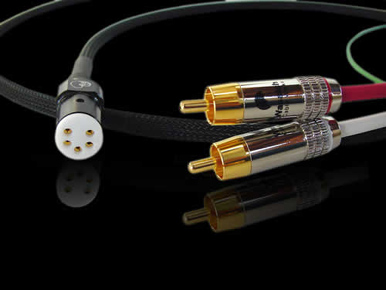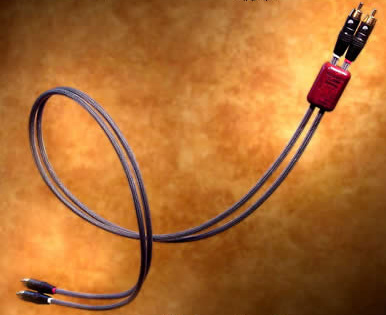You are reading the older HTML site
Positive Feedback ISSUE
12
march/april 2004
wasatch cable works
Ultama interconnect and speaker cables
as reviewed by Victor Chavira and Ed Morawski

|
VICTOR CHAVIRA'S SYSTEM: LOUDSPEAKERS ELECTRONICS SOURCE CABLES ACCESSORIES
|
 Mineral mining
and processing are two of Utah’s top industries, and as a result, several audio
cable companies operate in the Beehive state. Named after the towering mountains
located near their production facility, Wasatch Cable Works has been in business
since 2000. They sent us their near-top-of-the-line Ultama speaker cables ($4000
per 8-foot pair), Ultama interconnects ($1200 per meter), and PD-402 phono cable
($130) for review. Ultama cables feature a propriety combination of silver and
copper conductors in a twisted Litz geometry. These largely hand crafted cables
are terminated with high quality connectors and sheathed in a flexible
silver-gray woven material. Wooden accent pieces keep the cables evenly spaced
and indicate directionality.
Mineral mining
and processing are two of Utah’s top industries, and as a result, several audio
cable companies operate in the Beehive state. Named after the towering mountains
located near their production facility, Wasatch Cable Works has been in business
since 2000. They sent us their near-top-of-the-line Ultama speaker cables ($4000
per 8-foot pair), Ultama interconnects ($1200 per meter), and PD-402 phono cable
($130) for review. Ultama cables feature a propriety combination of silver and
copper conductors in a twisted Litz geometry. These largely hand crafted cables
are terminated with high quality connectors and sheathed in a flexible
silver-gray woven material. Wooden accent pieces keep the cables evenly spaced
and indicate directionality.
The Ultama speaker cables went into my system first, and immediately made a good impression in comparison to my reference Analysis Plus Oval 9s. The Ultamas revealed a more detailed and spacious soundstage. For example, my CD of Mambo Sinuendo by Ry Cooder and Manuel Galban sounded exceptionally vivid and transparent. Cooder and Galban’s guitars were rendered with greater presence, thus highlighting their various instruments and unique playing styles. The Ultama’s transparent and cohesive character was also well suited to this recording’s considerable percussion ensemble. Each musician’s kit was clearly outlined on an open stage. The Analysis Plus Oval 9s are very good cables, but they sounded heavier and less resolving of fine detail than the Ultamas.
Large-scale productions like the Mormon Tabernacle Choir’s The Sound of Glory on a Telarc hybrid CD sounded layered and finely focused. The sound of massed voices in harmony is the ultimate challenge for any system, and the Ultamas did not disappoint. Voices sang out with resplendent beauty and air. The Orchestra at Temple Square with conductor Craig Jessop performed in fine form, supporting the choir’s massive sea of finely tuned voices.
The real measure of greatness in cables occupying this price range is an extended and unstrained upper octave. The speakers and associated components most likely to be paired with the Ultama can be uncomfortably revealing. I was concerned that the use of silver in the Ultama cable would be its Achilles heel, but after much experimentation and listening, I believe that Wasatch Cable Works has created a speaker cable that is both highly resolving and listenable. For example, Jack DeJohnette’s expressive stick and brush strokes on his cymbals sounded crystal clear on Herbie Hancock’s 1996 CD, The New Standard, and Dave Holland’s acoustic bass firmly rooted the rhythm section with deep and pulsating notes.
My current bass test track is scene 11, "Treebeard," on the Lord of the Rings, The Two Towers DVD. With their digitally lowered voices and seismic footfalls, the giant Ents are a woofer’s nightmare. Nevertheless, the Ultama heavy-gauge construction allowed power to flow freely from amp to speaker. Even when the Ents’ speech and action occurred simultaneously in the lower octave, the Ultama deftly sorted out the dialog from the effects in my two-channel system.
The Wasatch Ultama interconnects exhibited all the characteristics of the speaker cables. Clarity, extension, and refinement best describe the sound of Ultama interconnects in my system. The Ultamas equaled the transparency of my reference Nordost Quattro Fils without the side effects of thinning the midband or enhancing the transient edges of sound waves. Although the Ultama interconnects brought my system a step closer to the sound of music by themselves, the combination of speaker cables and interconnects elevated the communicative nature of music in my home.

Finally, I listened to Wasatch’s PD-402 entry-level phono cable. At $130, the PD-402 may represent the greatest value in the Wasatch product line, and is a godsend for users of stock phono cables like this reviewer. The PD-403 is a meter of high-quality copper conductors in a noise-canceling geometry. One end of the cable is terminated with a sturdy plastic DIN, and the other is capped with lightweight alloy RCAs and a ground wire.
The PD-402 was miles ahead of the stock cable on my Linn Axis turntable, revealing more of the richness, color, and vibrancy I look for when listening to LPs. For example, my new copy of Miles Davis’ Kind of Blue from Classic Records sounded better than ever. The soundstage and images were more accurately defined. Tonal colors became more saturated, and the rhythm kicked along with greater dynamics. My well-preserved copy of Los Lobos’ Will the Wolf Survive? also sounded more engaging with the PD-402. Bass had greater grip and control, while guitars strummed with measured precision and speed. Vocal harmonies were rendered with enhanced resolution. More music was reaching my ears, in a more accurate manner than with the stock Linn phono cable.
In closing, the Wasatch Cable Works interconnects and speaker cables represent the best of what the cable industry has to offer without the associated hype. Wasatch cables outperformed my reference cables in every parameter, and allowed me to be drawn into music with less effort. It is no wonder that one dealer at CES told me that he experienced the least number of returns with Wasatch cables than with any other products he carried. Highly recommended. Victor Chavira

ED MORAWSKI'S SYSTEM: LOUDSPEAKERS ELECTRONICS SOURCE CABLES ACCESSORIES
|
 All too often, a
reviewer’s job is impossibly mired in shades of subtle nuance. We struggle to
hear minute differences in equipment to give both the reader and the
manufacturer a fair appraisal, when in fact it is often difficult to hear any
change. This seems especially true when cables are the issue. Many reviewers
would rather take a trip to the dentist than succumb to the editor’s demands to
do another cable review. It was a slow after-holiday period, and I couldn’t make
it to CES, so I agreed to do one on Wasatch Cables.
All too often, a
reviewer’s job is impossibly mired in shades of subtle nuance. We struggle to
hear minute differences in equipment to give both the reader and the
manufacturer a fair appraisal, when in fact it is often difficult to hear any
change. This seems especially true when cables are the issue. Many reviewers
would rather take a trip to the dentist than succumb to the editor’s demands to
do another cable review. It was a slow after-holiday period, and I couldn’t make
it to CES, so I agreed to do one on Wasatch Cables.
For once, I was pleasantly surprised. I didn’t have to pull out the trusty thesaurus to find new words for what I heard. I digress, so let me start from the beginning. I received two sets of the Ultama Interconnects with RCA terminations and one pair of LC-605 speaker cables. I was pleased to discover how thin and flexible the cables were. They were a far cry from the norm! Not only did I not have to fight them around binding posts (or corners) but they didn’t threaten to push my equipment off its rack. (By the way, for those cable naysayers out there, I was one of you not all that long ago, but can assure you that they do matter—on a really good system you can easily hear the difference.)
Taking a wild gamble after seeing how nice they looked, I replaced all my cables at once. The Ultama interconnects went from my E.A.R. 864 preamp to my Musical Fidelity Nu-Vista CD player and to my Plinius SA-102 amp. The speaker cables completed the path from the SA-102 to my speakers. After sliding Madonna’s American Life into the CD player, I prepared to strain my ears. Whoa! The soundstage expanded all the way across the room and around to the sides! Even more important, however, was the 3D imaging that popped out across that expanse. Every single instrument, plus the backup vocalists, sprang into being with a personality.
This was quite an experience. My system never sounded this real before. Each new track jolted me into an awareness of placement and detail that I had not heard before. Madonna’s music has some wild effects, so after enjoying this CD, I put in a Loreena McKennitt disc to see if the cables would provide that wonderful imaging. Not to worry. "The Visit" and "Parallel Dreams" were just superb—richly detailed, with previously unheard nuances. Not quite believing my ears, I walked away from my system for a few days while some out-of-town visitors needed to be toured around Southern California. When I came back, the Wasatch cables again accomplished their magic. At this point I was convinced, and checked the Wasatch website to see just how dear the cables were. They are on the expensive side—$1200 for the Speaker cables and $1200 for each set of interconnects.
Hoping beyond hope that it was just one set of cables that was working the magic, I removed the interconnects one set at a time. First to go was the preamp-to-amp set. The soundstage remained wide, but the extraordinary three-dimensional quality receded drastically. As each set of Wasatch cables was replaced, the detail suffered accordingly. By the time my original cables were back in place, I found myself sorely missing the improvements. After listening to my own cables for a day, I replaced them again with the Wasatch, one set at a time. Interestingly, it was not until the Wasatch cables completely replaced my reference set that the incredible imaging returned. I guess the conclusion is that I will have to spent at least $3600 to achieve audio nirvana.
In the days that followed, I listened to every type of music I had on hand, and had the most enjoyable time I have ever spent in my music room. Norah Jones in particular will always stick in my mind. I love this recording, and now it was better than ever. Nuances that were never apparent before came to life in a marvelously subtle manner. At the end of one of the tracks, the drummer can be heard to finish his set with a tiny little tap on the drums. I had never noticed this before. It was like listening to every piece of music I own for the first time. I highly recommend these cables, and now have to figure out how to delay returning them! Ed Morawski
Wasatch Cable Works
web address:
www.wasatchcableworks.com
